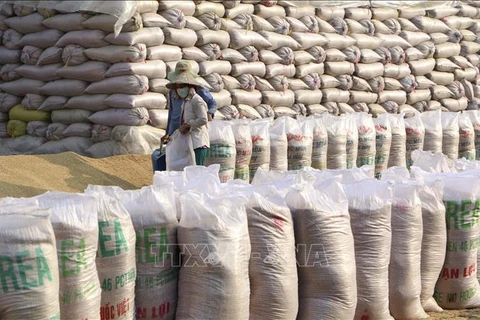Hanoi (VNA) – The Ministry of Industry and Trade (MoIT) is close monitoring rice production and the world rice market with a view to promptly tackling arising problems and facilitating rice production, business and export.
Statistics showed that as of the end of October, Vietnam exported 7.1 million tonnes of rice for about 3.97 billion USD, a rise of 17% in volume and 34.9% in value over 2022. Vietnamese export rice price increased 15.3% year on year.
In the first nine months of 2023, Asia was the largest market of Vietnam, consuming 76% of the country’s total rice export volume. It was followed by Australia with 2.41%, Europe 1.6% and America 1.5%.
 As of the end of October, Vietnam exported 7.1 million tonnes of rice for about 3.97 billion USD, a rise of 17% in volume and 34.9% in value over 2022. (Photo: VNA) Particularly, the Philippines continued to be the biggest importer of Vietnam's rice with nearly 2.5 million tonnes, accounting for 38.1% of Vietnam's total rice export volume.
As of the end of October, Vietnam exported 7.1 million tonnes of rice for about 3.97 billion USD, a rise of 17% in volume and 34.9% in value over 2022. (Photo: VNA) Particularly, the Philippines continued to be the biggest importer of Vietnam's rice with nearly 2.5 million tonnes, accounting for 38.1% of Vietnam's total rice export volume.
According to the MoIT, Vietnam has been keeping to the right direction on rice export structure and quality as outlined by the rice export market development strategy until 2030, with white rice accounting for the largest share (55.5% or 3.56 million tonnes), followed by fragrant rice (24% or 1.5 million tonnes) and sticky rice (8.5% or 545,000 tonnes).
In the face of complicated developments in global food trade, including India's ban on export of non-basmati white rice, Russia's withdrawal from the Black Sea Grain Initiative, climate change and El Nino phenomenon, the MoIT has coordinated with the Ministry of Agriculture and Rural Development and the People’s Committees of rice production localities, the Vietnam Food Association as well as rice traders to roll out various measures to regulate rice production and export activities in 2023, while ensuring the stability of the domestic rice market.
At the same time, the MoIT has regularly inspected rice business and exporting activities of traders. It has revoked the rice export certificate from 28 traders who did not export rice for 18 consecutive months after receiving the certificate, contributing to creating a business environment that is more open, transparent, and fairer in line with the law./.
Statistics showed that as of the end of October, Vietnam exported 7.1 million tonnes of rice for about 3.97 billion USD, a rise of 17% in volume and 34.9% in value over 2022. Vietnamese export rice price increased 15.3% year on year.
In the first nine months of 2023, Asia was the largest market of Vietnam, consuming 76% of the country’s total rice export volume. It was followed by Australia with 2.41%, Europe 1.6% and America 1.5%.
 As of the end of October, Vietnam exported 7.1 million tonnes of rice for about 3.97 billion USD, a rise of 17% in volume and 34.9% in value over 2022. (Photo: VNA)
As of the end of October, Vietnam exported 7.1 million tonnes of rice for about 3.97 billion USD, a rise of 17% in volume and 34.9% in value over 2022. (Photo: VNA) According to the MoIT, Vietnam has been keeping to the right direction on rice export structure and quality as outlined by the rice export market development strategy until 2030, with white rice accounting for the largest share (55.5% or 3.56 million tonnes), followed by fragrant rice (24% or 1.5 million tonnes) and sticky rice (8.5% or 545,000 tonnes).
In the face of complicated developments in global food trade, including India's ban on export of non-basmati white rice, Russia's withdrawal from the Black Sea Grain Initiative, climate change and El Nino phenomenon, the MoIT has coordinated with the Ministry of Agriculture and Rural Development and the People’s Committees of rice production localities, the Vietnam Food Association as well as rice traders to roll out various measures to regulate rice production and export activities in 2023, while ensuring the stability of the domestic rice market.
At the same time, the MoIT has regularly inspected rice business and exporting activities of traders. It has revoked the rice export certificate from 28 traders who did not export rice for 18 consecutive months after receiving the certificate, contributing to creating a business environment that is more open, transparent, and fairer in line with the law./.
VNA
























